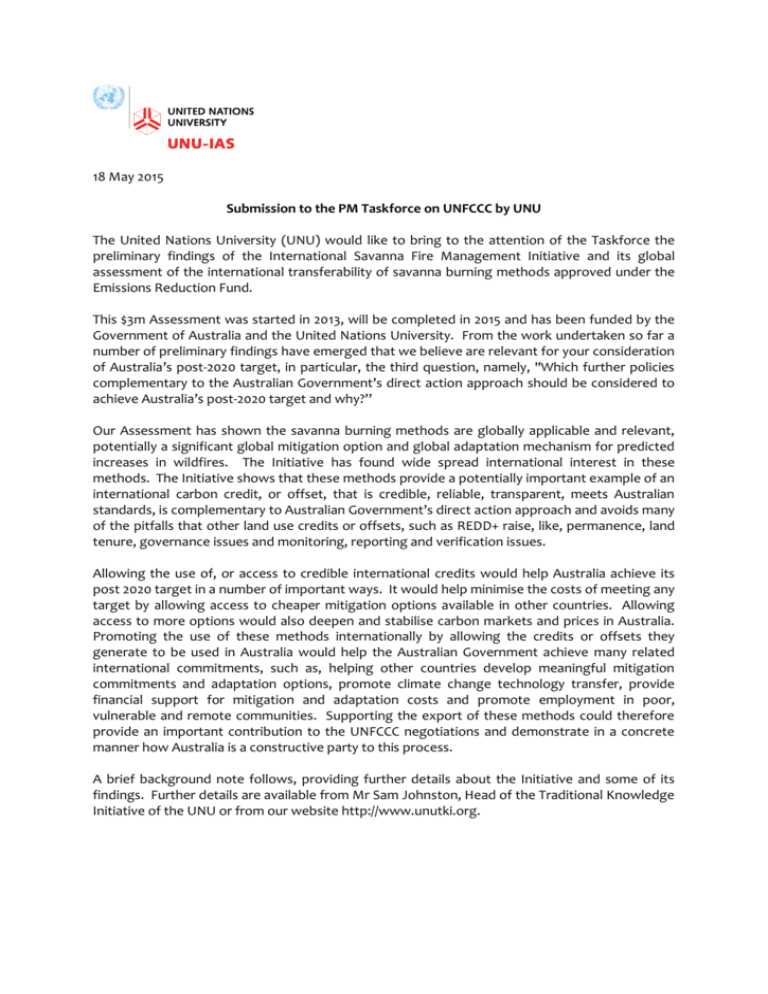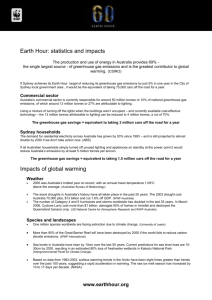United Nations University Submission redacted
advertisement

18 May 2015 Submission to the PM Taskforce on UNFCCC by UNU The United Nations University (UNU) would like to bring to the attention of the Taskforce the preliminary findings of the International Savanna Fire Management Initiative and its global assessment of the international transferability of savanna burning methods approved under the Emissions Reduction Fund. This $3m Assessment was started in 2013, will be completed in 2015 and has been funded by the Government of Australia and the United Nations University. From the work undertaken so far a number of preliminary findings have emerged that we believe are relevant for your consideration of Australia’s post-2020 target, in particular, the third question, namely, "Which further policies complementary to the Australian Government’s direct action approach should be considered to achieve Australia’s post-2020 target and why?” Our Assessment has shown the savanna burning methods are globally applicable and relevant, potentially a significant global mitigation option and global adaptation mechanism for predicted increases in wildfires. The Initiative has found wide spread international interest in these methods. The Initiative shows that these methods provide a potentially important example of an international carbon credit, or offset, that is credible, reliable, transparent, meets Australian standards, is complementary to Australian Government’s direct action approach and avoids many of the pitfalls that other land use credits or offsets, such as REDD+ raise, like, permanence, land tenure, governance issues and monitoring, reporting and verification issues. Allowing the use of, or access to credible international credits would help Australia achieve its post 2020 target in a number of important ways. It would help minimise the costs of meeting any target by allowing access to cheaper mitigation options available in other countries. Allowing access to more options would also deepen and stabilise carbon markets and prices in Australia. Promoting the use of these methods internationally by allowing the credits or offsets they generate to be used in Australia would help the Australian Government achieve many related international commitments, such as, helping other countries develop meaningful mitigation commitments and adaptation options, promote climate change technology transfer, provide financial support for mitigation and adaptation costs and promote employment in poor, vulnerable and remote communities. Supporting the export of these methods could therefore provide an important contribution to the UNFCCC negotiations and demonstrate in a concrete manner how Australia is a constructive party to this process. A brief background note follows, providing further details about the Initiative and some of its findings. Further details are available from Mr Sam Johnston, Head of the Traditional Knowledge Initiative of the UNU or from our website http://www.unutki.org. Preliminary Findings of the International Savanna Fire Management Initiative An Initiative financed by the Government of Australia through Australian Aid 1. Global Impact of Wildfire Wildfires annually burn a total land area of between 3.5 and 4.5 million km2, equivalent to India and Pakistan together, or more than half of Australia. Wildfires affect every region of the world. Reported losses generated by wildfires over the past decade (2002–2011) were on average US$2.4 billion per year. Wildfires have been estimated by the Economics of Ecosystems and Biodiversity (TEEB) to destroy ecosystem services in the range of US$146–US$191 billion per year. The latest Intergovernmental Panel on Climate Change (IPCC) assessment (5AR) concluded that wildfires represent an important source of greenhouse gases. The latest research estimates that globally landscape and biomass fires contribute CO2 emissions of between 2 and 4 Pg C yr-1, 60% of which comes from grassland/savanna/woodland, which is equivalent to between 12-24% of emissions from fossil-fuel combustion in 2011, or 3.8-7.7 Gt CO2e yr-1 (e.g. Beringer et al “Fire in Australian savannas: from leaf to landscape” Global Change Biology (2015) 21, 62–81, doi: 10.1111/gcb.12686). The IPCC in 5AR concluded that impacts from wildfires reveal significant vulnerability and exposure of some ecosystems and many human systems to current climate variability. The IPCC also highlighted the greater likelihood of injury and death due to more intense fires and a major health impact of climate change in throughout the 21st Century. The following maps show the amount of carbon emitted from wildfires each year and the dominant type of wildfires. Annual fire carbon emissions (gCm-2year-1) Dominant fire type Source: van der Werf GR, Randerson JT, Giglio L et al (2010) Global fire emissions and the contribution of deforestation, Savanna, forest, agricultural, and peat fires (1997–2009). Atmos Chem Phys 10:11707–11735 Fire dependant ecosystems such as tropical dry forests and savannas cover around one-sixth of the global land surface. A major problem in these landscapes is poor fire regimes result in the prevalence of large destructive fires that emit more greenhouse gases than well-managed areas. The prevalence of wildfire is predicted to increase as a result of climate change. As illustrated in the two following diagrams, NASA predicts that global fire activity could increase by between 5 and 35% by 2100 and that most of these increases will take place in these fire dependent landscapes (see http://www.nasa.gov/topics/earth/features/fiery-past.html). The history of fire dependant landscapes around the world is remarkably similar. Historically all of these landscapes were dominated by fire regimes that were actively managed by the indigenous people by lighting low-intensity, early dry season fires to create fire breaks and prevent the build up of fuel, which minimised later dry season destructive wildfires. The stability of this fire regime at a global scale is illustrated in NASA’s Global fire activity variations map above, where fire activity was constant between 850 until 1750. With colonisation by Europeans of these landscapes the fire management activities of indigenous people were supressed for a variety of reasons. This resulted in an increase in late dry season fires and an increase of fire activity between 1750 and 1950. Since the 1950s fire activity has dropped globally, which reflects the diminishing amount of savannas and tropical dry forest due to their conversion to western style agriculture, such as cattle ranching, soya bean and palm oil production. 2. Traditional Fire Management and Climate Change in Australia Australia is leading the world in terms of experience in managing wildfires and understanding the role that fire plays in climate change. In Northern Australia, Aboriginal people have managed land for generations by using TFM. The first project to use TFM to generate carbon credits was the Western Arnhem Land Fire Agreement (WALFA) that started in 2006. The adjacent fire maps for Western Arnhem Land illustrate the impact of the reintroduction of traditional fire. Under the Carbon Farming Initiative (CFI), there are now 34 TFM projects, with 14 either indigenous owned or have significant indigenous involvement. WALFA% Project% area% before% reintroduc4on% of% TFM% in% 2005% and% a: er% in% 2009% with% red% areas% being% burnt% late% and% orange% early% early late The methodology for measuring the reduction of greenhouse gas emissions and NASA based satellite monitoring systems for reporting and verifying the carbon credits under the CFI are ground breaking regulatory developments with global implications. The application of TFM has also generated substantial additional or co-benefits including creating market based jobs in remote and vulnerable communities. improving biodiversity, reinvigorating culture, improving food security and health. 3. Global Assessment With support from the Government of Australia and a range of partners, UNU is undertaking a two year detailed assessment of the feasibility of transferring savanna burning “technology” developed under the CFI to countries in Asia, Africa and Latin America (the Assessment). The Assessment, which is due to be completed in 2015, will produce the following outcomes: Learning tools, workshops and learning exchanges in and among three main savanna regions of the world - Southern Africa, Latin America and Asia; Feasibility assessments identifying other promising regions of the world; Greater awareness in international processes about TFM, especially the UNFCCC; and Exploration of market interest in the technology. Further details are available at http://www.unutki.org. 4. Preliminary Findings The Initiative’s Global Assessment is due to be published in the second half of 2015. Preliminary findings include the following. Mitigation The preliminary findings indicate that the methodology for measuring the reduction of greenhouse gas emissions could be adapted to many other fire dependant landscapes around the world and that satellite monitoring and data is available and can be easily further built upon for all regions for reporting and verifying the carbon credits. The findings has also found that better fire management, through the application of the proven Australian technology of TFM, could lead to reductions of wildfire emissions by as much as a half, reducing global greenhouse emissions by more than 1GtCO2e/year, with significant further emissions mitigation through carbon sequestration over the long term. Adaptation The preliminary findings indicate that this technology represents an important – in many cases the only viable – adaptation mechanism to the increased wildfire predicted to occur as a result of climate change. Interest The Initiative has confirmed strong interest in the technology in many key countries, including in Indonesia, Timor Leste, Papua New Guinea, Myanmar, Cambodia, Namibia, Mozambique, South Africa, Tanzania, Botswana, Angola, Zimbabwe, Zambia, Madagascar, Peru, Mexico, Brazil, Colombia, Venezuela, Guatemala and Belize. Indigenous people, philanthropic organisations and companies such as ConocoPhillips, INPEX and BHP Billiton are also interested in this technology. In many of these countries there is interest, readiness and a strong desire to begin immediate on the ground practical work. Co-benefits The preliminary findings indicate that the technology has great potential to deliver the types of extra benefits seen in Australia under the CFI. These include creating market based jobs in remote and vulnerable communities, promoting biodiversity, supporting tourism through retention of biodiverse landscapes, reinvigorating culture, improving food security and health. Market interest The preliminary findings indicate strong market interest in using the Australian technology internationally. The methodologies developed under the CFI meet all international or national standards. Major multinational companies are interested in considering how this technology might be useful for their operations. The Verified Carbon Standard has recently developed a methodology for Eastern Africa that is based on the CFI methodologies. The uncertainty surrounding the future of a global carbon market has not extinguished interest in this technology. The WALFA project, for instance, is funded by a carbon abatement arrangement with ConocoPhillips that runs from 2006 to 2023. Despite significant changes in the global and Australian carbon market since 2006 both ConocoPhillips and the traditional owners remain fully committed to the original agreement. Proven mature technology The preliminary findings indicate that because traditional fire management relies upon local communities applying proven technologies to generate annual abatement of wildfire emissions it avoids many significant problems that tend to arise with other land uses, such as REDD+ like, permanence, land tenure, governance issues and monitoring, reporting and verification issues (MRV). The Initiative has found that programs to reintroduce traditional fire practices for cultural and environmental reasons have already taken place in other countries, but none of these incorporate methodologies to quantify emissions reductions, like those developed under the CFI. Several of these projects, despite proven significant social and biodiversity benefits, have ended due to the lack of sustainability in funding models reliant on one off public and philanthropic grants. Where this is happening to add the technology would be a relatively straightforward matter that would markedly increase the viability of these efforts. Awareness The preliminary findings indicate that not enough had been known about the potential of this Australian technology and an important and globally significant opportunity for emissions reductions is not being properly exploited. The Initiative found despite the potential of this technology to provide an important contribution to the post 2020 UNFCCC regime, the SDGs and the post-2015 framework for disaster risk reduction there is no reference to this technology in any of the existing negotiating texts, nor is there enough awareness amongst the relevant stakeholders in these processes of this technology.







